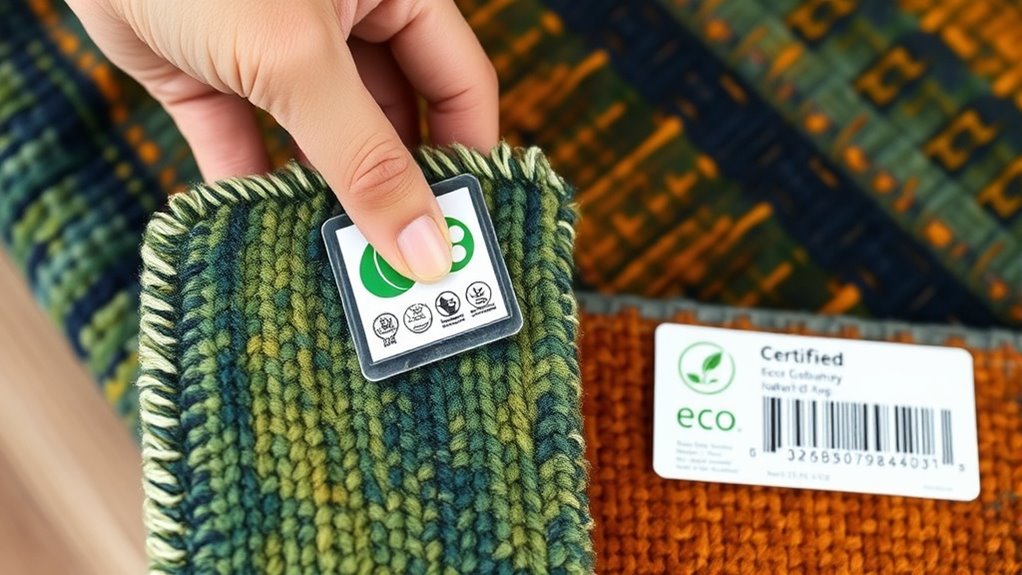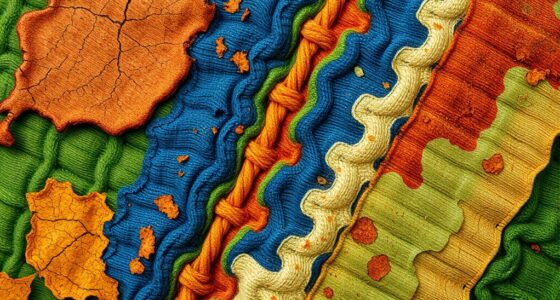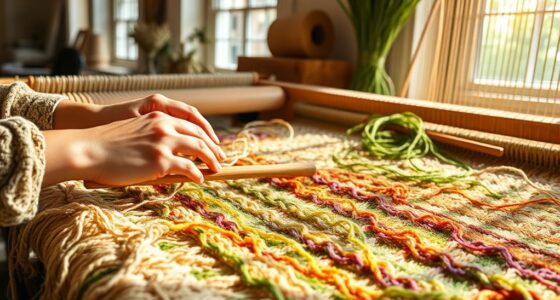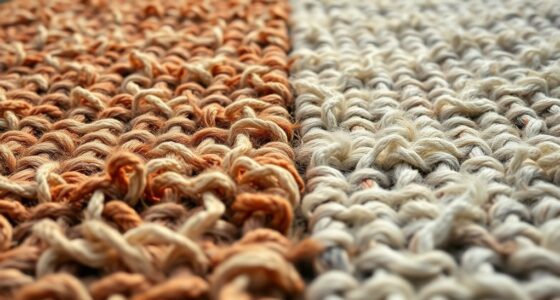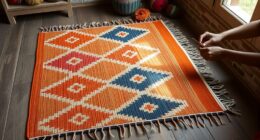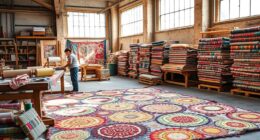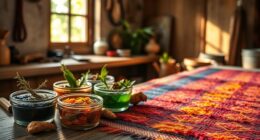When choosing eco-dyed rugs, look for certification labels like GOTS, OEKO-TEX Standard 100, and Fair Trade to guarantee they meet strict environmental and social standards. These labels verify that the dyes are safe, fibers are responsibly sourced, and fair labor practices are followed. Authentic certifications also confirm the rug’s traceability and safety. Continuing to explore will help you better understand how these labels protect your health and the planet.
Key Takeaways
- Look for recognized certification labels like GOTS and OEKO-TEX Standard 100 to verify eco-friendly dyes and safe manufacturing practices.
- Confirm labels are authentic by inspecting for clear logos, QR codes, or serial numbers, and verify through official databases.
- Choose rugs with traceability labels or documentation that detail raw materials and eco-conscious processes.
- Support fair trade and social responsibility certifications, which ensure fair wages and safe working conditions.
- Prioritize products with transparent supply chains and proper storage to reinforce genuine eco-friendly claims.
Understanding Eco-Certification Standards for Rugs
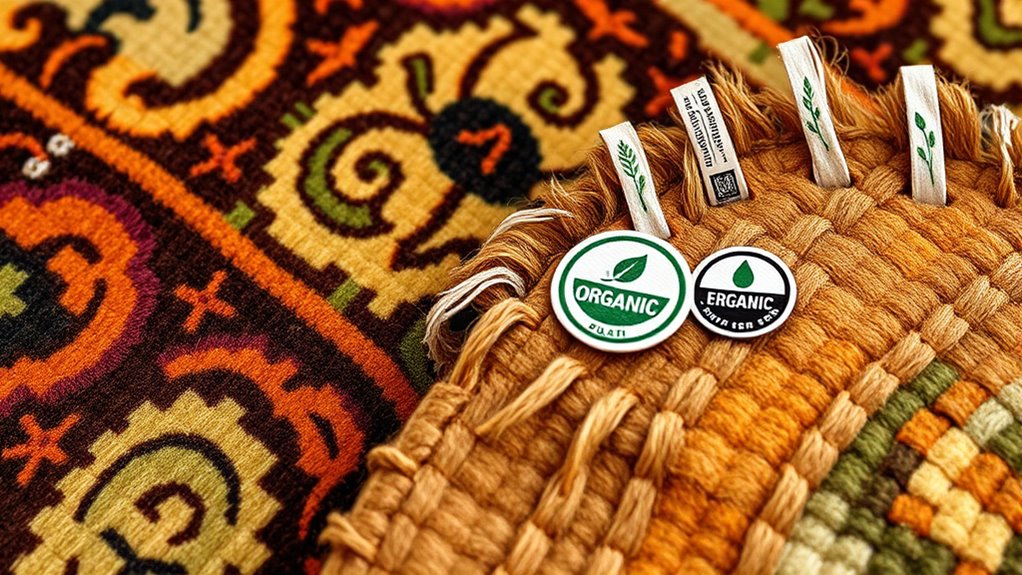
To guarantee your rug is truly eco-friendly, it’s important to understand the eco-certification standards that verify sustainable practices. These standards set clear benchmarks for environmentally responsible manufacturing, including the use of non-toxic dyes, sustainable raw materials, and eco-conscious production methods. Certifications like GOTS (Global Organic Textile Standard) or OEKO-TEX Standard 100 ensure that rugs meet strict environmental and social criteria. When a rug bears these labels, you can trust it was produced with minimal chemical impact and fair labor practices. Recognizing these certifications helps you make informed choices and supports brands committed to sustainability. Always check for official certification labels on the rug’s tag or packaging, and research what each label signifies to confirm the rug’s eco-friendly credentials.
Key Labels to Look for When Shopping for Eco-Dyed Rugs

When shopping for eco-dyed rugs, look for recognized certification programs that verify sustainable practices. Pay attention to eco-friendly dye labels that indicate safer, less harmful dyes are used. Also, check for authenticity and traceability labels to guarantee you’re getting a genuine, responsibly produced product. Additionally, understanding certification labels helps ensure the rug meets environmental and social standards.
Recognized Certification Programs
Recognized certification programs serve as trusted indicators of a rug’s eco-dyed credentials, helping you identify products that meet strict environmental and health standards. When shopping, look for labels from reputable organizations like GOTS (Global Organic Textile Standard), OEKO-TEX Standard 100, and the Green Label Plus. GOTS certifies organic fiber processing and environmentally responsible manufacturing, while OEKO-TEX ensures fabrics are free from harmful chemicals. The Green Label Plus focuses on low VOC emissions in carpets and rugs. These certifications require rigorous testing and regular audits, giving you confidence that the rug’s dyes and production processes prioritize safety and sustainability. By choosing products with these recognized labels, you support environmentally responsible practices and safeguard your health. Additionally, understanding the vetting process behind these certifications can help you make more informed and eco-conscious purchasing decisions.
Eco‑Friendly Dye Labels
Eco-friendly dye labels serve as essential guides for shoppers seeking sustainable and safe rugs. These labels indicate that the dyes used in the rug are environmentally friendly, often free from harmful chemicals and toxins. Look for labels such as GOTS (Global Organic Textile Standard) or OEKO-TEX Standard 100, which verify that dyes are tested for safety and eco-friendliness. Natural dye labels also signal that plant-based or mineral dyes are used, reducing chemical impact. When shopping, check for clear branding or certifications on the packaging or product tags. These labels help you make informed choices, ensuring your rug is not only beautiful but also environmentally responsible. By paying attention to eco-friendly dye labels, you prioritize health, sustainability, and ethical practices in your home. Additionally, choosing certified organic dyes can further guarantee that the dyes are produced sustainably and without harmful residues.
Authenticity and Traceability
To guarantee you’re truly getting an eco-dyed rug, look for key labels that verify authenticity and traceability. These labels ensure the rug’s origin and eco-friendly practices are transparent. Check for certifications like GOTS (Global Organic Textile Standard), which confirms organic fiber processing and ethical production. Look for traceability labels that provide details about the supply chain, from raw materials to finished product. Verify if the rug has a story or documentation backing its eco claims. Ask for brands that openly share their sourcing and dyeing processes. Trust labels that are recognized globally and include serial numbers or QR codes for tracking. Additionally, cybersecurity measures can help protect your purchase information from online threats, ensuring your transaction remains secure.
The Significance of GOTS Certification in Sustainable Textiles

Have you ever wondered what sets truly sustainable textiles apart? GOTS certification is a key indicator. It guarantees that the entire textile process meets strict environmental and social standards. When you see GOTS on a rug, you know it’s made with organic fibers, free from harmful chemicals, and produced ethically. This certification ensures safe working conditions and fair wages for workers. It also emphasizes eco-friendly dyeing, reducing water and energy consumption. By choosing GOTS-certified rugs, you support sustainable farming and manufacturing practices. It gives you confidence that your purchase aligns with your values for environmental health and social responsibility. In short, GOTS certification helps you make informed, conscious choices, ensuring your eco-dyed rug truly contributes to a greener, fairer world. Additionally, understanding emotional support can help consumers feel more connected to their eco-friendly choices, knowing they are contributing to a healthier planet and society.
What Oeko-Tex Certification Ensures for Rugs

Oeko-Tex certification guarantees that rugs are tested for harmful substances and meet strict safety standards. When a rug bears this label, you can trust it’s free from chemicals that could harm your health or the environment. This certification covers a wide range of safety aspects, ensuring the product is safe for daily use. It also confirms that:
- The dyes used are free from toxic residues
- No carcinogenic substances are present
- The materials meet human-ecological safety levels
- The manufacturing process minimizes chemical pollution
- The product complies with international safety regulations
- Vetted – Halloween Product Reviews ensures the reliability of safety claims and quality standards.
The Role of OEKO-TEX Standard 100 in Eco-Friendly Dyes

You want rugs that are safe and eco-friendly, and OEKO-TEX Standard 100 helps guarantee that. It verifies that dye materials meet strict safety criteria, so you can trust what’s used. Knowing the certification process is thorough gives you confidence in your eco-friendly choice. Additionally, vetting processes like AP Tuning ensure that these standards are consistently maintained for reliable quality.
Safety of Dye Materials
Ensuring the safety of dye materials is essential when choosing eco-dyed rugs, and the OEKO-TEX Standard 100 plays a critical role in this process. This certification guarantees dyes are tested for harmful substances, guaranteeing they’re safe for your home and health. When evaluating rugs, look for labels that confirm compliance with OEKO-TEX Standard 100, which involves rigorous testing for chemicals like:
- Heavy metals
- Formaldehyde
- Pesticides
- Allergens
- Carcinogens
This standard helps you avoid materials that could cause skin irritation or long-term health issues. Additionally, understanding credit card security measures can help you make safer purchasing decisions online. By choosing rugs with OEKO-TEX certification, you ensure that the dyes used are environmentally friendly and safe for everyday use. It’s your assurance that safety and sustainability go hand in hand in your eco-friendly rug choices.
Certification Verification Process
To verify that an eco-dyed rug meets safety standards, understanding the certification process is essential. The OEKO-TEX Standard 100 is a widely recognized certification that tests textiles for harmful substances. When a rug bears this label, it indicates that each component, from dyes to fibers, has undergone rigorous testing for chemicals and toxins. To confirm a rug’s certification, check for the OEKO-TEX label on the product or packaging. You can also verify the certification number online through the OEKO-TEX database. This process guarantees the rug complies with strict safety criteria, giving you confidence that it’s free from harmful substances. By understanding this process, you can make informed choices and prioritize both safety and eco-friendliness in your rug selection.
Recognizing Fair Trade and Social Responsibility Labels
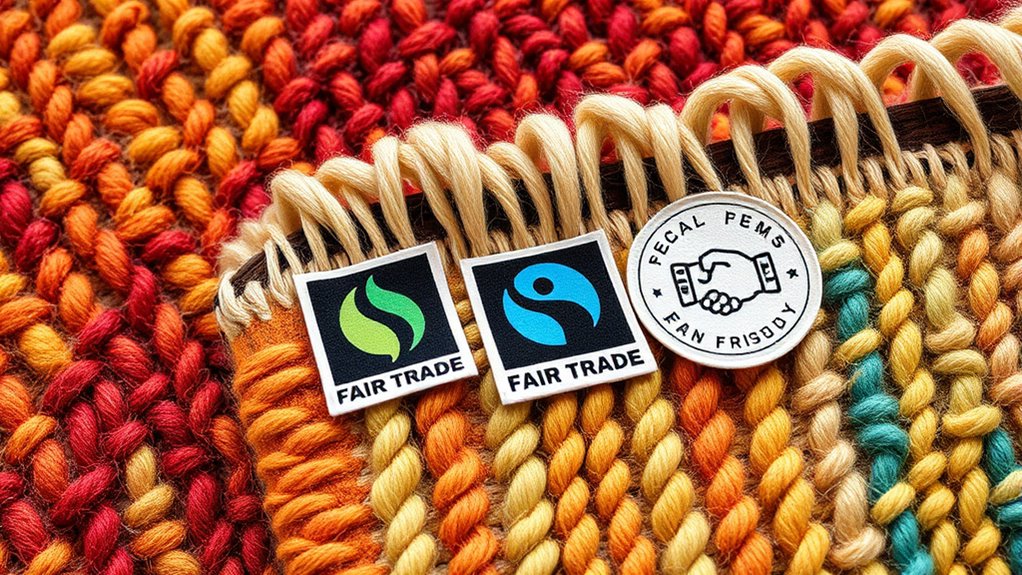
Recognizing fair trade and social responsibility labels on rugs helps you make informed choices that support ethical practices. These labels indicate that the rug’s production benefits workers and communities. Look for symbols or logos from recognized organizations like Fair Trade International or World Fair Trade Organization. These labels often guarantee fair wages, safe working conditions, and environmentally responsible methods. Paying attention to ethical sourcing ensures that your purchase contributes positively to social and environmental sustainability. To identify authentic labels, check for: – Clear certification logos from reputable organizations – Consistent labeling on packaging and tags – Information about the producer or cooperative – Details about fair wages and workers’ rights – Transparency in supply chain practices
Tips for Verifying Certification Authenticity in Retail Settings
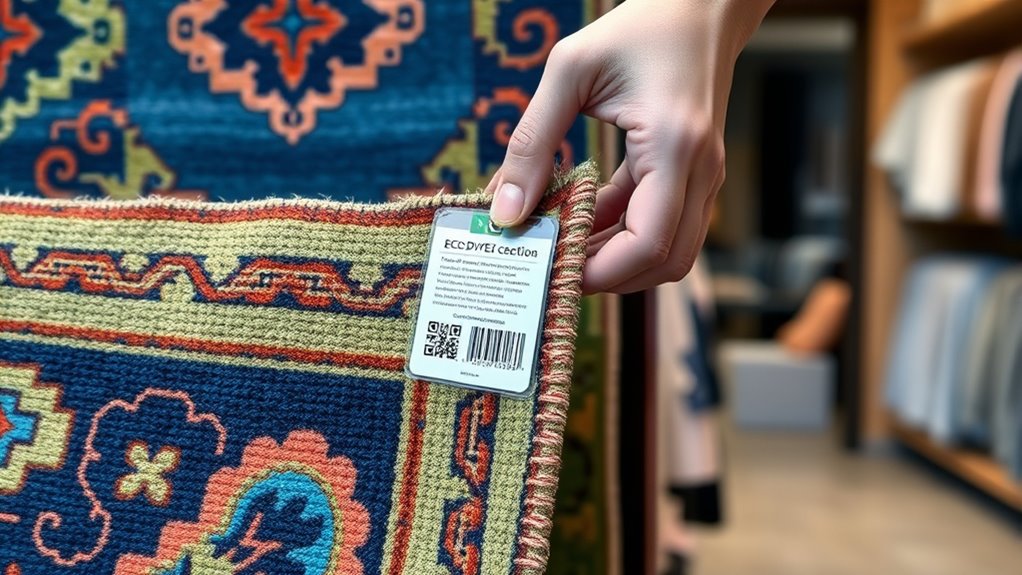
When shopping for eco-dyed rugs in retail stores, it’s important to verify that the certification labels are genuine. Start by closely inspecting the labels for clear logos and consistent printing quality. Be cautious of labels that look faded, blurry, or improperly affixed. Research the certifying organization beforehand to familiarize yourself with their official branding and certification process. Ask store staff for documentation or additional proof of certification if needed. Use your smartphone to scan QR codes or verify online databases linked to the certification body. Trust your instincts—if something seems off or the label appears fake, consider choosing another rug. Confirming the authenticity of labels ensures you’re supporting truly eco-friendly practices and making an informed purchase. Additionally, understanding the expiration of vape juice can help ensure product freshness and safety, highlighting the importance of verifying product authenticity and proper storage information.
Frequently Asked Questions
How Do Certification Labels Affect Rug Pricing and Affordability?
Certification labels can greatly impact rug pricing and affordability. When you see a certified eco-friendly label, you should know it often means higher costs due to sustainable sourcing and ethical practices. These costs are usually passed on to you, making the rug more expensive. However, investing in certified rugs can be worthwhile, as they ensure quality, environmental responsibility, and health benefits, ultimately providing better value in the long run.
Are Eco-Certified Rugs Suitable for Allergy Sufferers?
Imagine stepping into a fresh, clean forest after rain—that’s how eco-certified rugs can feel for allergy sufferers. These rugs are made with natural dyes and safer materials, reducing airborne irritants. By choosing eco-certified options, you’re creating a sanctuary that breathes easy and nurtures your well-being. They’re a gentle hug for your home, ensuring comfort without sacrificing style or safety.
How Often Should Eco-Certifications Be Renewed or Re-Evaluated?
You should check certification renewal periods regularly, typically every one to three years, depending on the certifying organization. Staying updated guarantees the eco-standards remain valid and trustworthy. Keep an eye on the certification labels on your eco-dyed rugs, as they often include expiry dates or renewal reminders. By actively monitoring these, you assure your rugs continue meeting eco-friendly criteria and maintain your home’s environmental integrity.
Can Eco-Certifications Guarantee the Absence of All Harmful Chemicals?
Can eco-certifications guarantee the absence of all harmful chemicals? Think of them as a lighthouse—guiding you through a fog of uncertainty. While they assure rigorous standards and reduce risks, they can’t guarantee perfection. Manufacturers might still encounter trace amounts or undisclosed substances. So, while certifications are a valuable step, stay informed and ask questions to make truly eco-friendly choices. After all, no system is foolproof, just dependable.
What Is the Best Way to Educate Consumers About Eco-Dyed Rug Benefits?
You can educate consumers about eco-dyed rug benefits by highlighting their environmental advantages through clear, simple messaging. Use social media, in-store displays, and packaging to explain how eco-dyeing reduces chemical use and pollution. Share stories and visuals that showcase the craftsmanship and sustainability aspects. Offering workshops or informational sessions can deepen understanding, making it easier for consumers to see the value and choose eco-friendly options confidently.
Conclusion
By choosing rugs with trusted eco-certification labels, you’re planting seeds of change in a garden of sustainability. These certifications act as your guiding stars, illuminating ethical craftsmanship amidst a sea of options. Relying on authentic labels ensures you’re weaving a tapestry of environmental and social responsibility, transforming your space into a sanctuary that nurtures both the planet and its people. Let your choices ripple outward, cultivating a greener, more mindful world with every step you take.
